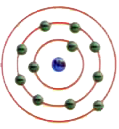State the atomic number and mass number of 2311Na and draw its atomic model.
To solve the question, we will break it down into two parts: finding the atomic number and mass number of the isotope 2311Na and then drawing its atomic model.
Step 1: Identify the Mass Number and Atomic Number
1. The given notation is \( \, _{11}^{23}Na \).
2. The mass number (A) is the number at the top (superscript), which is 23.
3. The atomic number (Z) is the number at the bottom (subscript), which is 11.
Solution:
- Mass Number (A) = 23
- Atomic Number (Z) = 11
Step 2: Determine the Number of Protons, Neutrons, and Electrons
1. The atomic number (Z) represents the number of protons in the atom. Therefore, the number of protons = 11.
2. The number of electrons in a neutral atom is equal to the number of protons. Thus, the number of electrons = 11.
3. To find the number of neutrons, use the formula:
\(
\text{Number of Neutrons} = \text{Mass Number} - \text{Atomic Number}
\)
Substituting the values:
\(
\text{Number of Neutrons} = 23 - 11 = 12
\)
Solution:
- Number of Protons = 11
- Number of Electrons = 11
- Number of Neutrons = 12
Step 3: Draw the Atomic Model
1. Nucleus: Draw a small circle to represent the nucleus. Inside this circle, write the number of protons and neutrons.
- Protons = 11
- Neutrons = 12
2. Electron Shells:
- The first shell can hold a maximum of 2 electrons. Place 2 electrons in the first shell.
- The second shell can hold a maximum of 8 electrons. Place 8 electrons in the second shell.
- The third shell can hold the remaining electrons. Since we have already placed 10 electrons, place 1 electron in the third shell.
Atomic Model:
- Nucleus: 11 protons and 12 neutrons
- Electron Shells:
- 1st shell: 2 electrons
- 2nd shell: 8 electrons
- 3rd shell: 1 electron
Final Atomic Model Representation
2e≤ctrons(1stshell)OOOOOOOOO(2ndshell)(3rdshell)O
- Nucleus: (11 protons + 12 neutrons)
Summary of the Solution
- Mass Number = 23
- Atomic Number = 11
- Protons = 11, Electrons = 11, Neutrons = 12
1. The given notation is \( \, _{11}^{23}Na \).
2. The mass number (A) is the number at the top (superscript), which is 23.
3. The atomic number (Z) is the number at the bottom (subscript), which is 11.
- Mass Number (A) = 23
- Atomic Number (Z) = 11
1. The atomic number (Z) represents the number of protons in the atom. Therefore, the number of protons = 11.
2. The number of electrons in a neutral atom is equal to the number of protons. Thus, the number of electrons = 11.
3. To find the number of neutrons, use the formula:
\(
\text{Number of Neutrons} = \text{Mass Number} - \text{Atomic Number}
\)
Substituting the values:
\(
\text{Number of Neutrons} = 23 - 11 = 12
\)
- Number of Protons = 11
- Number of Electrons = 11
- Number of Neutrons = 12
1. Nucleus: Draw a small circle to represent the nucleus. Inside this circle, write the number of protons and neutrons.
- Protons = 11
- Neutrons = 12
2. Electron Shells:
- The first shell can hold a maximum of 2 electrons. Place 2 electrons in the first shell.
- The second shell can hold a maximum of 8 electrons. Place 8 electrons in the second shell.
- The third shell can hold the remaining electrons. Since we have already placed 10 electrons, place 1 electron in the third shell.
- Nucleus: 11 protons and 12 neutrons
- Electron Shells:
- 1st shell: 2 electrons
- 2nd shell: 8 electrons
- 3rd shell: 1 electron
2e≤ctrons(1stshell)OOOOOOOOO(2ndshell)(3rdshell)O
- Nucleus: (11 protons + 12 neutrons)
- Mass Number = 23
- Atomic Number = 11
- Protons = 11, Electrons = 11, Neutrons = 12
Topper's Solved these Questions
- RADIOACTIVITYBOOK - ICSECHAPTER - RADIOACTIVITYEXERCISE - MULTIPLE CHOICE TYPE
6 Videos
- RADIOACTIVITYBOOK - ICSECHAPTER - RADIOACTIVITYEXERCISE - EXERCISE-12(B)
19 Videos
- RADIOACTIVITYBOOK - ICSECHAPTER - RADIOACTIVITYEXERCISE - NUMERICALS
2 Videos
- QUESTION PAPER-2019BOOK - ICSECHAPTER - QUESTION PAPER-2019EXERCISE - SECTION-II
42 Videos
- REFRACTION OF LIGHTBOOK - ICSECHAPTER - REFRACTION OF LIGHTEXERCISE - DIAGRAM BASED MCQ:
5 Videos
Similar Questions
Knowledge Check
If the mass number of an element is W and its atomic number is N, then
Anumber of 0−1e=W−NBnumber of 11H=W−NCnumber of 10e=W−NDnumber of 10n=N
The atomic number and the mass number of an atom remains unchanged when it emits
View SolutionDifferentiate between the atomic number and the mass number.
View SolutionWrite the complete symbol of:
a. The nucleus with atomic number 56 and mass number 138
The nucleus with atomic number 26 and mass number 55
c. The nuleus with atomic number 4 and mass number 9
View SolutionThe atomic number and mass number of sodium are 11 and 23 respectively. What information is conveyed by this statement?
View SolutionIf the atomic number and the mass number of X are 72 and 180 then the mass number and atomic number of X4 are-
View SolutionWrite the complete symbol
a. The nucleus with atomic number 16 and mass number 82
b. The nucleus with atomic number 35 and mass number 80
c. The nucleus with atomic number 4 and mass number 9
View SolutionAtom with the same atomic number and different mass numbers are called
View Solution

